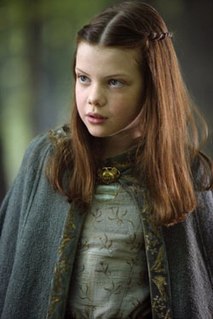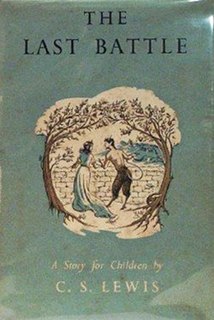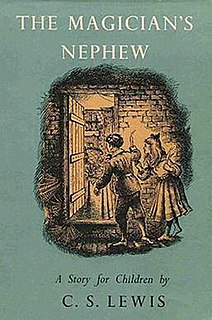The Magician's Nephew
The place where Digory, Polly, Frank the cabman, Strawberry the horse, Jadis and Uncle Andrew first enter the uncreated Narnia would become Lantern Waste. Jadis, angry and afraid at the sight of Aslan, immediately wants to kill him but her magic powers do not work so she needs a weapon. She improvises by throwing something at his head and the thing she happens to have in her hand at the time is a piece from a lamppost she'd taken from London. It falls to the ground without having any effect on Aslan when it hits him and does not appear to have hurt him at all. The fresh new fertile ground of Narnia causes anything that lands on it to sprout and grow, so the fragment sprouts into a full lamppost that shines day and night. The site of the lamppost is also where small trees of gold and silver grew from some dropped coins that were also brought from London by Mr Ketterly, Digory's wicked uncle. Those gold and silver trees would later be used to make King Frank's and Queen Helen's crowns, and they were also where Digory planted the Tree of Protection that kept Jadis away for many years.

Professor Digory Kirke (1888-1949) is a fictional character from C. S. Lewis' fantasy series The Chronicles of Narnia. He appears in three of the seven books: The Lion, the Witch and the Wardrobe, The Magician's Nephew, and The Last Battle.
Polly Plummer (1889-1949) is a major fictional character from C. S. Lewis's fantasy series The Chronicles of Narnia. She appears in two of the seven books: The Magician's Nephew and The Last Battle.

Fledging is the stage in a volant animal's life between hatching or parturition and flight. This term is most frequently applied to birds, but is also used for bats. For altricial birds, those that spend more time in vulnerable condition in the nest, the nestling and fledging stage can be the same. For precocial birds, those that develop and leave the nest quickly, a short nestling stage precedes a longer fledging stage.
The Lion, the Witch and the Wardrobe
When Lucy hides in a wardrobe in the Professor's house, she finds herself in Lantern Waste, where she meets Tumnus the Faun. Later her brother Edmund finds his way in and meets the White Witch there.

The faun is a mythological half human–half goat creature appearing in Ancient Rome.

Edmund "Ed" Pevensie is a fictional character in C. S. Lewis's The Chronicles of Narnia series. He is a principal character in three of the seven books, and a lesser character in two others.

Jadis is the main antagonist of The Magician's Nephew and of The Lion, the Witch and the Wardrobe in C. S. Lewis's series, The Chronicles of Narnia. She is commonly referred to as the White Witch in The Lion, the Witch and the Wardrobe, as she is the Witch who froze Narnia in the Hundred Years Winter.
Years later, the four children, now Kings and Queens of Narnia, are hunting in Lantern Waste when they come across the spot where they first entered Narnia and stumble back into the Professor's house in England.
This page is based on this
Wikipedia article Text is available under the
CC BY-SA 4.0 license; additional terms may apply.
Images, videos and audio are available under their respective licenses.

Narnia is a fantasy world created by C. S. Lewis as the primary location for his series of seven fantasy novels for children, The Chronicles of Narnia. The world is so called after the country of Narnia, in which much of the action of the Chronicles takes place.

Tumnus is a fictional character in the Narnia books, written by C.S. Lewis. He is featured prominently in The Lion, the Witch and the Wardrobe and also appears, with a lesser role, in The Horse and His Boy and The Last Battle. He is close friends with Lucy Pevensie and is the first creature she meets in Narnia, as well as the first Narnian to be introduced in the series. Lewis said that the first Narnia story, The Lion, the Witch and the Wardrobe, all came to him from a single picture he had in his head of a faun carrying an umbrella and parcels through a snowy wood. In that way, Tumnus was the initial inspiration for the entire Narnia series.

Peter Pevensie is a fictional character in C. S. Lewis's The Chronicles of Narnia book series. Peter appears in three of the seven books; as a child and a principal character in The Lion, the Witch and the Wardrobe and Prince Caspian, and as an adult in The Last Battle. He is only mentioned in The Horse and His Boy in which he is away on the northern frontier fighting giants and in The Voyage of the Dawn Treader in which he is studying under the tutelage of Professor Kirke.

Cair Paravel is the fictional castle where the Kings and Queens of Narnia rule in The Chronicles of Narnia. It is the location of the four thrones of High King Peter the Magnificent, High Queen Susan the Gentle, King Edmund the Just, and Queen Lucy the Valiant.

The Chronicles of Narnia: The Lion, the Witch and the Wardrobe is a 2005 British-American high fantasy film directed by Andrew Adamson and based on The Lion, the Witch and the Wardrobe, the first published and second chronological novel in C. S. Lewis's children's epic fantasy series, The Chronicles of Narnia. It was co-produced by Walden Media and Walt Disney Pictures and distributed by Buena Vista Pictures. William Moseley, Anna Popplewell, Skandar Keynes and Georgie Henley play Peter, Susan, Edmund, and Lucy, four British children evacuated during the Blitz to the countryside, who find a wardrobe that leads to the fantasy world of Narnia. There they ally with the Lion Aslan against the forces of Jadis, the White Witch.
In C. S. Lewis's fantasy novel series the Chronicles of Narnia, the hill of the Stone Table, or Aslan's How, is a high mound or cairn south of the Great River in Narnia next to the Great Woods. The How was built over the hill of the Stone Table. The word how derives from the Old Norse haugr, meaning hill or mound. In parts of England, it is a synonym for barrow.

Aslan is a major character in C. S. Lewis's The Chronicles of Narnia series. He is the only character to appear in all seven books of the series. C.S. Lewis often capitalises the word lion in reference to Aslan since he parallels Jesus Christ.
The Lion, the Witch and the Wardrobe is a British children's television drama first broadcast by the BBC in 1988. It was the first series of The Chronicles of Narnia that ran from 1988 to 1990.
C. S. Lewis' fantasy series The Chronicles of Narnia includes several battles set in Narnia, Archenland, and other places in the Narnian World. These are given below in an in-universe, fictional chronology while listing them in order of appearance.
The following outline is provided as an overview of and topical guide to Narnia:
















